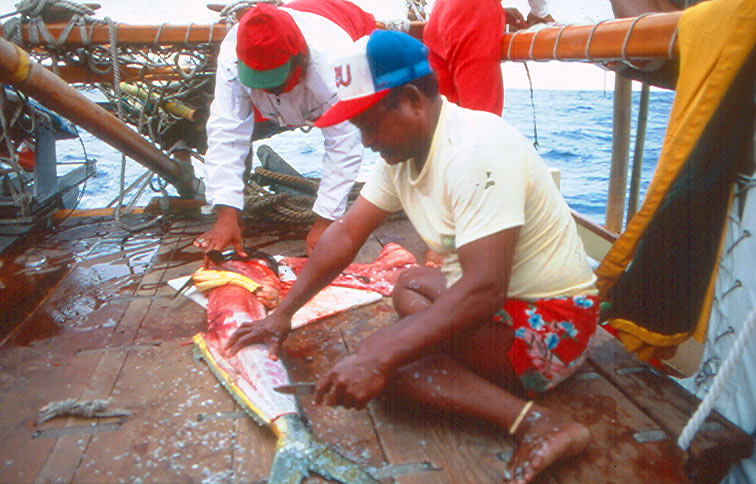Fishing Aboard Hōkūle‘a
The only way to supplement food supplies on an ancient voyaging canoe at sea was to catch fish, and possibly birds. Fishing was a matter of survival. In the same tradition, fishing is more than just a pastime on Hokule'a. A good-sized fish provides a day or two of food for the crew and allows the crew to stretch its supply of food and lengthen the time the crew can survive at sea.
One crew member on board the canoe serves as a designated fisherman, responsible for putting out the lines at sunrise, bringing in the catch with the assistance of other crew members, and pulling in the lines at sunset.
Hōkūle‘a trails up to four 400 pound-test fishing lines, with lures attached. Two of the lines extend out from each side of the canoe on bamboo poles to prevent the lines from tangling. The canoe needs to travel at 6-7 knots for good results. The crew catches a range of open ocean fish, including aku (bluefin tuna), 'ahi (yellowfin tuna), mahimahi (dorado), ono (wahoo), and a'u (billfish). On the 29-day voyage to Tahiti in 1992, 35 fish were caught; on the 35-day voyage from Rarotonga to Hawai'i in 1992, 27 fish were caught, including a 150-pound and a 200-pound marlin.

Mau cutting up an ono, 1985-1987 voyage. Kamehameha Schools Archives
Fish is appreciated by the crew because it is the only fresh food eaten during the voyage after the fruits and vegetables have been consumed, usually within the first few days. The fish is eaten raw, marinated for po-ke, or fried.

A raw fish meal. 2007 Voyage to Satawal.
The leftover fish parts and bones are used to make soup. Leftover strips of meat are dried from the rigging, then put into buckets as snacks for the crew.
